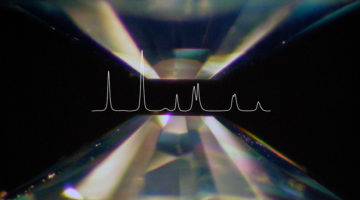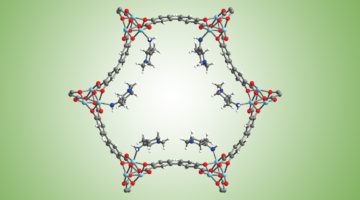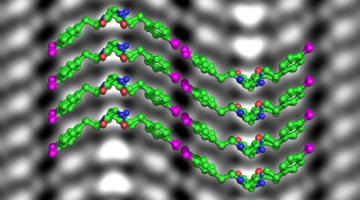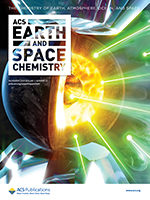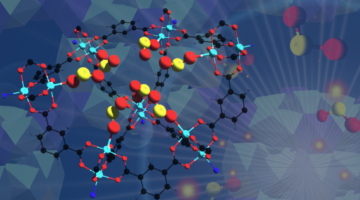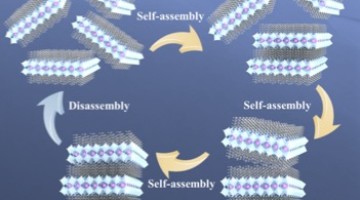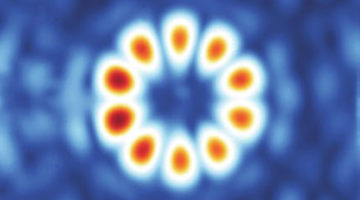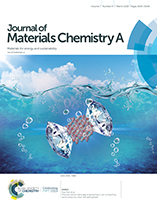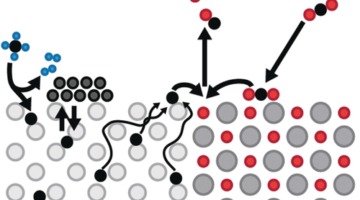Earth is considered a watery planet, simply by virtue of the fact that 71% of its surface is covered by oceans. But researchers have discovered that, in the massive volume of material in Earth’s interior, minerals can serve as an important water reservoir, providing a new perspective on our planet’s water budget. Read more »
Water Improves Material’s Ability to Capture CO2
With the help of the ALS, researchers from UC Berkeley and ExxonMobil fine-tuned a material to capture CO2 in the presence of water. The parties have applied for a patent on the material, which was developed for use on the relatively humid flue gases emitted by certain natural gas power plants, a cleaner-burning alternative to coal. Read more »![]()
![]()
Freeze Frame: Scientists Capture Atomic-Scale Snapshots of Artificial Proteins
Protein-like molecules called polypeptoids have great promise as precision building blocks for creating a variety of designer nanomaterials. In this study, rsearchers used cryo-EM, a technique originally designed to image proteins in solution, as well as x-ray scattering techniques, to characterize the structure of polypeptide nanosheets. Read more »
Argon: Not So Noble in Earth’s Core
Researchers demonstrated the synthesis of a thermodynamically stable compound of argon and nickel at temperatures and pressures representative of the Earth’s core. The ability of argon, a noble gas, to react with other elements under these conditions may help solve outstanding geological questions, including the “missing argon paradox.” Read more »![]()
A High-Pressure Compound of Argon and Nickel: Noble Gas in the Earth’s Core?
Researchers demonstrated the synthesis of a thermodynamically stable compound of Ar and Ni at thermodynamic conditions representative of the Earth’s core. The results suggest that the abundance of Ar in the Earth’s core is beyond a simple solubility of Ar in molten Ni–Fe but in chemical reactions in nature. Read more »
New MOF Can Take On Toxic Sulfur Dioxide Gas
An international team has developed a robust material that can selectively take in toxic sulfur dioxide gas at record concentrations and preserve it for use in chemical production. The researchers verified its performance using a combination of techniques that included x-ray experiments at the ALS. Read more »
Self-Assembling Nanomaterials Are Organized and Tunable
Perovskite superlattices have a wide variety of applications, but they are difficult to synthesize. Researchers have now characterized their self-assembly process to better understand how to create a variety of superlattice materials. Read more »
A New Twist in Soft X-Ray Beams
Visible-light beams with orbital angular momentum (OAM) have been used in applications ranging from communications and imaging to particle manipulation. Now, researchers have generated high-quality OAM beams in the soft x-ray regime, with intriguing possibilities for future use at high-coherence, diffraction-limited light sources. Read more »
Pressure-driven band gap engineering in ion-conducting semiconductor silver orthophosphate
This work explores a novel method to tune the electronic band structures of active semiconductor photocatalysts to gain insight into structure–property relationships. Taking silver orthophosphate (Ag3PO4) as an example, a static pressure technique was applied to modulate the band gap and indirect–direct band character via altering its crystal structure and lattice parameters. Read more »
Palladium and Zirconium Convert Greenhouse Gases into Fuel
Greenhouse gases cause the rising global temperatures associated with climate change. At the ALS, researchers have determined that palladium/zirconium catalysts can reduce greenhouse gases like methane and carbon dioxide by converting them into useful fuel. Read more »![]()
